
Features
MRO
Establishing the Right Fix
Optimistic. This one word best describes how MRO (maintenance, repair and overhaul) operators and industry analysts are feeling about the future of the Canadian MRO market. There are a few key factors behind the sentiment according to Ray Jaworski, senior aerospace analyst with Forecast International.
September 27, 2010 By James Careless
Optimistic. This one word best describes how MRO (maintenance, repair and overhaul) operators and industry analysts are feeling about the future of the Canadian MRO market. There are a few key factors behind the sentiment according to Ray Jaworski, senior aerospace analyst with Forecast International. “We are seeing an improvement in commercial airline traffic, which helps the MROs who service these planes. The general aviation sector, which was extremely hard hit following the drop in business jet usage, is coming back. And the military MRO sector is holding steady.”
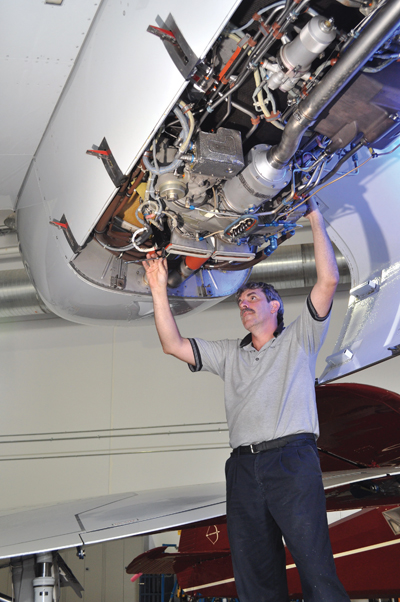 |
|
| AME Rick Wilde doing an inspection on the engine of a Citation X business jet.
|
Factors behind the slowdown
It’s a good thing the MRO market is looking up, because last year was not a good one for many MRO operators. Globally, commercial MRO revenues fell on the order of five to 10 per cent in 2009, according to research compiled by AeroStrategy Management Consulting. The biggest factor was the drop in aircraft usage, as commercial and business passenger numbers fell, thus lengthening the times between scheduled aircraft maintenance. However, price-cutting also hurt MRO bottom lines as operators scrambled for the business that was still available.
Another factor was the decision by airlines to retire older aircraft due for service in favour of fuel-efficient new aircraft fresh from the factory floor (and thus not needing MRO service). Add the cost-saving strategy of salvaging still viable engines and other parts from parked older aircraft and using them on those still flying – as opposed to servicing engines due for overhaul on schedule – and MROs saw yet another hit to their pocketbooks.
The overall result: “It’s been a tough time for MROs, especially in Canada and the U.S. which have lost business to lower-cost MROs in emerging countries,” Jaworski notes. “But things are better this year than they were in 2009, and things appear to be improving.”
We’re still here
The 2009-2010 recession pounded Canadian MROs big and small, and in response, jobs were cut. A case in point was in March 2010 at Aveos Fleet Performance (formerly known as Air Canada Technical Services), when Air Canada’s MRO laid off 195 employees for good, and 815 more until things improved. Fortunately, things did improve for Aveos, the company starting to recall laid off workers in July 2010, with the goal of taking them all back by 2011. As for other Canadian MROs? Based on those who spoke with Wings magazine, the economic storm was tough but survivable.
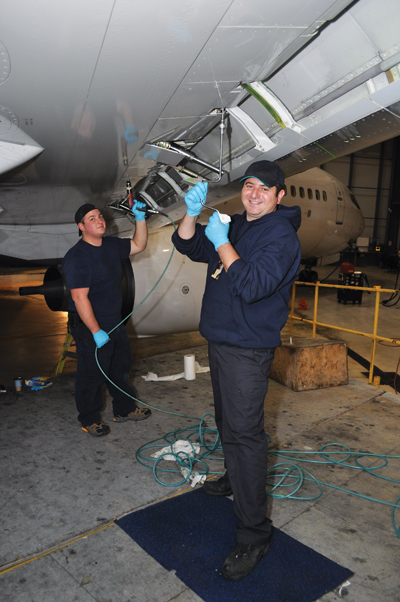 |
|
| AMEs Joe Zammuto and Michael Wegner open the access panels under the wing in preparation for an inspection. |
“We certainly felt the pain experienced by commercial transport operators in recent years, particularly in the U.S.,” says David Schellenberg, president and CEO of Abbotsford, B.C.-based Cascade Aerospace. “But with our commercial and military mix and our strategic shift into more complex and long-term major programs, our business is thriving nicely.” Indeed. Cascade Aerospace was awarded a 20-year contract with Lockheed Martin for third line maintenance and in-service support of Canada’s new fleet of C-130J Super Hercules aircraft in March 2010, and is the prime contractor for the fleet management of Canada’s legacy fleet of 32 C-130E & H model Hercules aircraft. The company also provides aircraft maintenance and modification services to Canadian commercial operators such as WestJet, First Air and Canjet.
In Nova Scotia, the pain of the recession has been very real. “We saw our business slow down in general by about 14 per cent,” says Uli Huber, director of maintenance with Atlantic Avionics in Enfield (Halifax International Airport). Sales of equipment suffered “due to a lack of customers reaching into their pockets; plus there’s increased competition for [equipment] sales. If no value is added, the customer can surf the net and shop anywhere for the best price – and they do.”
Across the country in Lethbridge, Alta., Jon Galenzoski, FBO manager with Airwest Flight Support says, “Business has been fairly steady in general aviation, which is who we service. Frankly, our biggest problem is the weather, not the economy. If conditions are bad for flying – and it gets very windy here in Lethbridge on a regular basis – then customers fly their aircraft less frequently. That delays them from coming in for regular maintenance, which hurts us.”
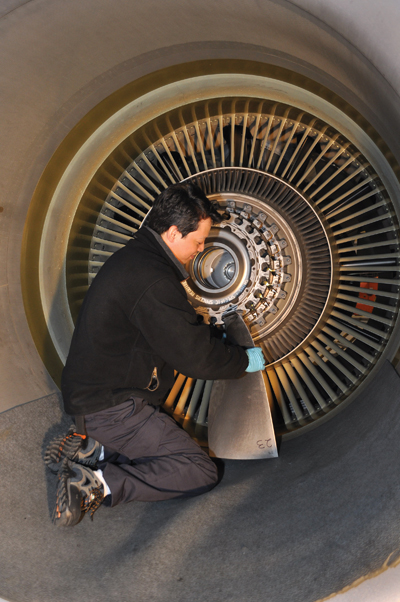 |
|
| AME Rhoderick Santiaguel changes out the fan blades on a CFM56-7B engine.
|
At Quantum Aviation in Toronto (Pearson International Airport), “the recession has had a minimal impact on our business,” says Mark Francis, the company’s president. “All of our customers have weathered the storm and we have managed to grow, albeit slowly. Our specialized shops – sheet metal structure repair, batteries, avionics – are not as busy as we had hoped. They were put in place to support our in-house needs but are more than capable of supporting more.”
Coping strategies
Surviving a recession is not a foregone conclusion. Doing it takes tough decisions and a willingness to do things differently. For instance, StandardAero has been able to leverage the diversity of its business and the breadth of products within single locations to manage and smooth out the impact that the recession has had, says Ian Smart, StandardAero’s SVP for Airlines & Fleets. “We have been able to cross-train employees on various engine types and move them throughout the company to have them in the places where they are needed most,” he says.
Quantum Aviation’s recession strategy translated into doing more in-house while doing everything possible to keep customers happy and coming back. “We have expanded our capabilities to rely less on outside services and continue to focus closely on our customers individual requirements,” says Francis. As a result of these efforts, “our busiest area is now corporate aviation maintenance. I believe it’s because we offer our customers highly competitive rates, top quality service and the convenience of staying at home while spending Canadian dollars to complete all their heavy maintenance needs.”
Atlantic Avionics has adopted a similar strategy, with similarly positive results. “We have done our best to watch expenses, improve customer service, and expand the capability of our shop repairs,” Huber says. The result: “Flight line maintenance is busier than before due to our improved services and 24 hour availability.”
As for Airwest: “Our response to the recession was to do a lot more advertising, to bring more people to our FBO,” says Galenzoski. “It appears to have worked, because we have generated a lot more new business in the past year than we have before.”
Ongoing challenges
Even though MRO revenues are recovering, the industry still has many ongoing challenges to deal with. For example, at Atlantic Avionics, the trend for manufacturers to exchange faulty parts rather than repair them is cutting into the company’s bottom line. “The way that most new equipment are being built makes in-house repairs impossible,” Huber says. “This is why so many items are now being sent back directly to the manufacturer, rather than being repaired in shops such as ours. We need to find ways of making up for the loss of these repairs, such as expanding our level of equipment and training so that we can troubleshoot defective ‘boxes.’ ”
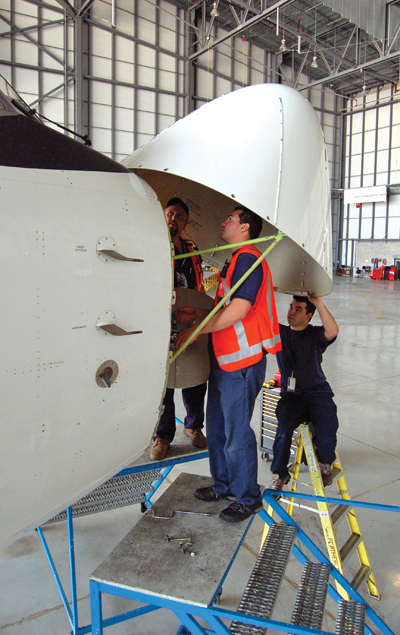 |
|
| AMEs fixing the weather radar in the nose of a Boeing 737.
|
StandardAero’s biggest challenge at this time is training people. “We have a growing CF34 facility and have recently signed up to be a Designated Fulfillment Center for CFM56,” Smart says. “Both of these products require growth in the size of the facilities and the number of people required to support them. We expect to hire more than 250 new people in Winnipeg by 2012 in order to support these two products, and properly managing the training of all these new hires remains our greatest hurdle.” In order to handle the influx of new hires, StandardAero has partnered with Red River College to create a Gas Turbine Targeted Engine entry-level program. It will provide new employees with basic fundamental skills and knowledge along with targeted engine training.
Attracting more commercial traffic is Airwest Flight Support’s biggest challenge, says Galenzoski. “Being an independently-owned FBO, we don’t see as much of the commercial carriers as an Esso FBO does,” he observes. “They seem to have an easier time in getting commercial contracts. That’s something we need to do to increase our revenues and diversify our base.”
Quantum Aviation’s Francis has many ongoing issues to deal with. Of these, “our biggest challenges are juggling the rising costs for parts, training and manpower while providing cost effective solutions for our customers.” If that’s not enough, “finding available hangar space at Pearson is becoming a problem. We have the work, but we need to be able to expand to do it and attract even more.”
Better times ahead
Despite all these challenges and an uncertain economy, the MROs who spoke with Wings for this article are undeniably positive about the rest of 2010 and 2011.
“We are very optimistic about the future,” says Schellenberg. “By continuing to build close relationships with key OEMs such as Lockheed Martin, CAE Inc. and others, and by capitalizing on our major program management experience and expertise to develop our international business, we are very confident that our future is strong and bright.”
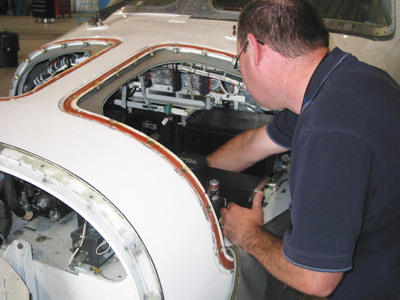 |
|
| Atlantic Avionics has improved services and added 24-hour availability to combat the economic downturn.
|
“Yes, we are optimistic about the future,” echoes Francis. “It appears that corporate aviation is starting to see a gradual increase in demand, and we are ready to support it.”
StandardAero is also very bullish about the future. The reason: “We have worked hard to strategically position ourselves both before and throughout the recession to grow our business through diversification, long-term customer relationships, and continual investment to stay in the forefront of aviation,” Smart says. “The CFM56 licence is the first element in our plans and investment in moving the business forward. Entry into the large-fan MRO market signals robust growth and a strong future for StandardAero.”
Atlantic Avionics DOM Huber sums it up: “New technology and increased flying will make this an exciting line of business to be in. Things are getting better.” With any luck, this optimism will be rewarded by higher revenues, better sales and more jobs in the months and years ahead for all MROs. After the economic storms of 2009-2010, the Canadian MRO industry certainly seems to be well positioned to respond to the changing needs of the industry.